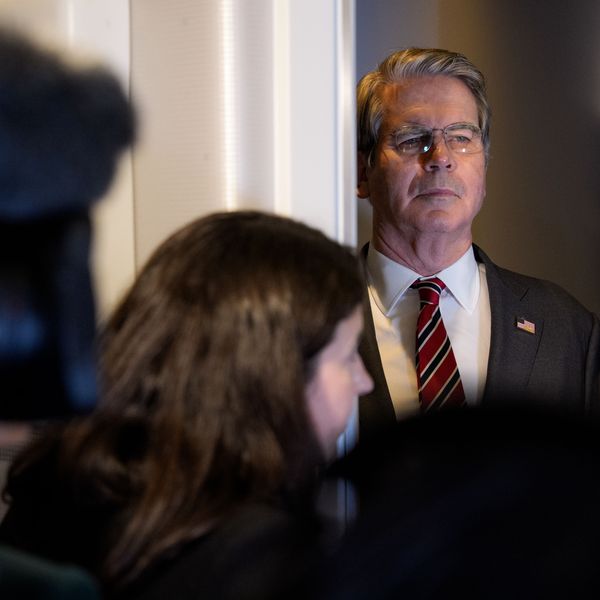
Trade organizations are using nonprofit tax rules to wriggle out of disclosing spending, according to a new report. (Photo: Staff Sgt. Joshua J. Garcia/U.S. Air Force/cc)
'Distressing': Report Details How Trade Organizations Plow Billions in Unaccountable Cash to Lobby Lawmakers
"People forget about them because they've just been there [collecting] large sums of money for a very long time."
A new report from nonprofit research group MapLight details the way that trade organizations spend huge amounts of money on lobbying that's seldom accounted for due to tax reporting loopholes.
MapLight examined how trade organizations are using legal loopholes in their status as 501(c)(6) nonprofit groups to funnel hundreds of millions--even billions--of dollars in lobbying lawmakers to push industry priorities.
According to the report:
The Internal Revenue Service has approved thousands of applications for nonprofit status for such organizations, which range from the U.S. Chamber of Commerce, which spends more on lobbying than any other trade organization, to the Washington State Society of Anesthesiologists. Their influence has grown substantially since the Supreme Court's 2010 Citizens United decision allowed them to spend directly on politics.
With a combination of large cashflows and secrecy, said University of Miami law professor Frances R. Hill, an expert in the U.S. tax code, comes the opportunity to use an almost unlimited slush fund to influence policy.
"The trade associations are more alien to a lot of people who are interested in exempt organizations than the 501(c)(3) public charities or 501(c)(4) social welfare organizations, which have become standard campaign participants," said Hill. "As long as people don't really bother you and aren't too upset about you, you can do fairly amazing or distressing things."
Examples of the unregulated spending uncovered by MapLight include:
- The American Petroleum Institute, $15 million in expenses for "advocacy consulting."
- The National Association of Home Builders, $2.2 million for advocacy.
- The Motor & Equipment Manufacturers Association, $706,000 on "trade and tax advocacy."
The secrecy doesn't end there, MapLight reported:
Nonprofits are only required to itemize their "other fees for services" if they account for more than 10 percent of their total functional expenses, which offers some trade associations an additional avenue for secrecy. For example, since the American Hospital Association listed more than $126 million in total functional expenses in 2017, it didn't need to spell out any of the items included in its $12 million line for "other fees for services."
The story, by reporters Andrew Perez, Tim Zelina, and Abigail Luke, was published on Tuesday morning and is part of an investigation produced by MapLight with The Intercept and Tarbell.
Most of the groups did not return requests for comment, telling reporters that their tax filings spoke for themselves.
That's in line with the kind of secrecy the trade organizations are used to, explained University of Miami's Hill--the groups are not accustomed to the spotlight.
"People forget about them because they've just been there [collecting] large sums of money for a very long time," said Hill.
An Urgent Message From Our Co-Founder
Dear Common Dreams reader, The U.S. is on a fast track to authoritarianism like nothing I've ever seen. Meanwhile, corporate news outlets are utterly capitulating to Trump, twisting their coverage to avoid drawing his ire while lining up to stuff cash in his pockets. That's why I believe that Common Dreams is doing the best and most consequential reporting that we've ever done. Our small but mighty team is a progressive reporting powerhouse, covering the news every day that the corporate media never will. Our mission has always been simple: To inform. To inspire. And to ignite change for the common good. Now here's the key piece that I want all our readers to understand: None of this would be possible without your financial support. That's not just some fundraising cliche. It's the absolute and literal truth. We don't accept corporate advertising and never will. We don't have a paywall because we don't think people should be blocked from critical news based on their ability to pay. Everything we do is funded by the donations of readers like you. Will you donate now to help power the nonprofit, independent reporting of Common Dreams? Thank you for being a vital member of our community. Together, we can keep independent journalism alive when it’s needed most. - Craig Brown, Co-founder |
A new report from nonprofit research group MapLight details the way that trade organizations spend huge amounts of money on lobbying that's seldom accounted for due to tax reporting loopholes.
MapLight examined how trade organizations are using legal loopholes in their status as 501(c)(6) nonprofit groups to funnel hundreds of millions--even billions--of dollars in lobbying lawmakers to push industry priorities.
According to the report:
The Internal Revenue Service has approved thousands of applications for nonprofit status for such organizations, which range from the U.S. Chamber of Commerce, which spends more on lobbying than any other trade organization, to the Washington State Society of Anesthesiologists. Their influence has grown substantially since the Supreme Court's 2010 Citizens United decision allowed them to spend directly on politics.
With a combination of large cashflows and secrecy, said University of Miami law professor Frances R. Hill, an expert in the U.S. tax code, comes the opportunity to use an almost unlimited slush fund to influence policy.
"The trade associations are more alien to a lot of people who are interested in exempt organizations than the 501(c)(3) public charities or 501(c)(4) social welfare organizations, which have become standard campaign participants," said Hill. "As long as people don't really bother you and aren't too upset about you, you can do fairly amazing or distressing things."
Examples of the unregulated spending uncovered by MapLight include:
- The American Petroleum Institute, $15 million in expenses for "advocacy consulting."
- The National Association of Home Builders, $2.2 million for advocacy.
- The Motor & Equipment Manufacturers Association, $706,000 on "trade and tax advocacy."
The secrecy doesn't end there, MapLight reported:
Nonprofits are only required to itemize their "other fees for services" if they account for more than 10 percent of their total functional expenses, which offers some trade associations an additional avenue for secrecy. For example, since the American Hospital Association listed more than $126 million in total functional expenses in 2017, it didn't need to spell out any of the items included in its $12 million line for "other fees for services."
The story, by reporters Andrew Perez, Tim Zelina, and Abigail Luke, was published on Tuesday morning and is part of an investigation produced by MapLight with The Intercept and Tarbell.
Most of the groups did not return requests for comment, telling reporters that their tax filings spoke for themselves.
That's in line with the kind of secrecy the trade organizations are used to, explained University of Miami's Hill--the groups are not accustomed to the spotlight.
"People forget about them because they've just been there [collecting] large sums of money for a very long time," said Hill.
A new report from nonprofit research group MapLight details the way that trade organizations spend huge amounts of money on lobbying that's seldom accounted for due to tax reporting loopholes.
MapLight examined how trade organizations are using legal loopholes in their status as 501(c)(6) nonprofit groups to funnel hundreds of millions--even billions--of dollars in lobbying lawmakers to push industry priorities.
According to the report:
The Internal Revenue Service has approved thousands of applications for nonprofit status for such organizations, which range from the U.S. Chamber of Commerce, which spends more on lobbying than any other trade organization, to the Washington State Society of Anesthesiologists. Their influence has grown substantially since the Supreme Court's 2010 Citizens United decision allowed them to spend directly on politics.
With a combination of large cashflows and secrecy, said University of Miami law professor Frances R. Hill, an expert in the U.S. tax code, comes the opportunity to use an almost unlimited slush fund to influence policy.
"The trade associations are more alien to a lot of people who are interested in exempt organizations than the 501(c)(3) public charities or 501(c)(4) social welfare organizations, which have become standard campaign participants," said Hill. "As long as people don't really bother you and aren't too upset about you, you can do fairly amazing or distressing things."
Examples of the unregulated spending uncovered by MapLight include:
- The American Petroleum Institute, $15 million in expenses for "advocacy consulting."
- The National Association of Home Builders, $2.2 million for advocacy.
- The Motor & Equipment Manufacturers Association, $706,000 on "trade and tax advocacy."
The secrecy doesn't end there, MapLight reported:
Nonprofits are only required to itemize their "other fees for services" if they account for more than 10 percent of their total functional expenses, which offers some trade associations an additional avenue for secrecy. For example, since the American Hospital Association listed more than $126 million in total functional expenses in 2017, it didn't need to spell out any of the items included in its $12 million line for "other fees for services."
The story, by reporters Andrew Perez, Tim Zelina, and Abigail Luke, was published on Tuesday morning and is part of an investigation produced by MapLight with The Intercept and Tarbell.
Most of the groups did not return requests for comment, telling reporters that their tax filings spoke for themselves.
That's in line with the kind of secrecy the trade organizations are used to, explained University of Miami's Hill--the groups are not accustomed to the spotlight.
"People forget about them because they've just been there [collecting] large sums of money for a very long time," said Hill.

